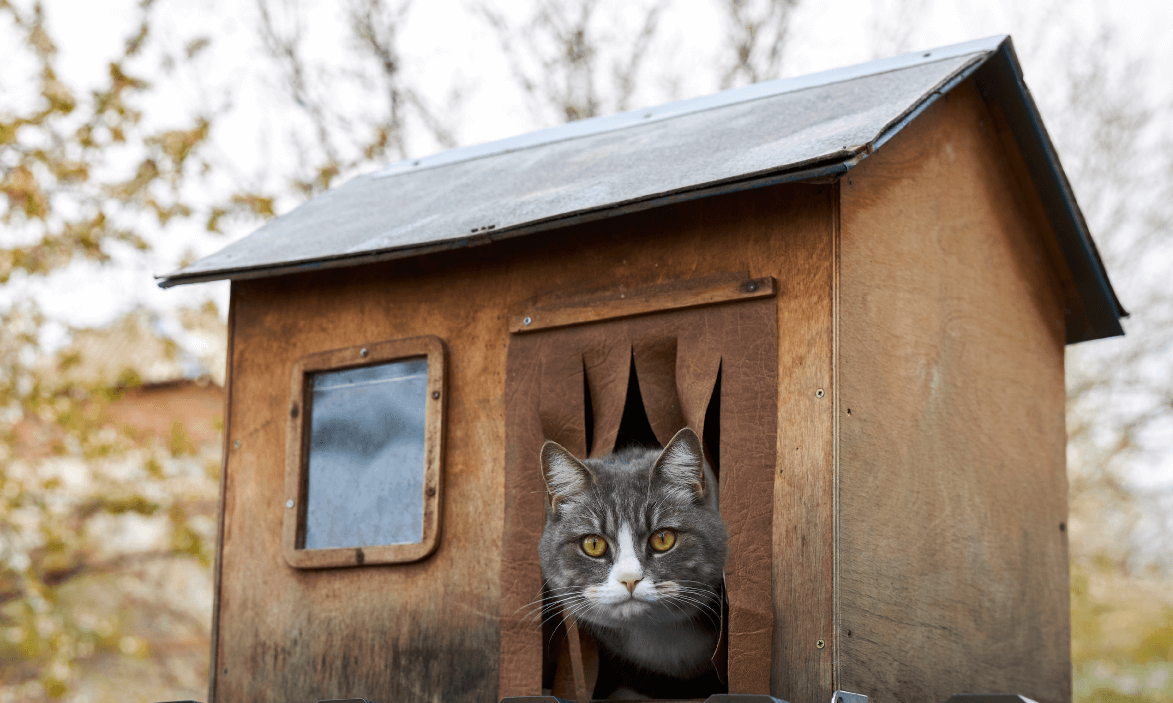When temperatures drop or storms roll in, outdoor cats can benefit immensely from a safe, dry shelter. But feral and stray cats are often cautious of unfamiliar structures, so encouraging them to use a shelter can take some patience and strategic thinking. This guide offers tips on how to create an inviting, secure shelter for a stray or feral cat and simple steps to help them adopt it as a safe haven.
1. Create or Choose a Shelter That Feels Safe and Protected
Feral and stray cats instinctively seek small, cozy spaces where they feel hidden and secure. To increase the chances they’ll use a shelter, choose one that is the right size, shape, and design.
Key Shelter Features to Look For:
- Compact, Enclosed Design: A smaller shelter feels cozier and safer for an outdoor cat and retains heat more effectively than an open shelter.
- Two Exits: Cats feel safer in shelters with an emergency exit in case they need to flee. Look for a shelter with two doors, or make a DIY shelter with a second small exit that can be hidden.
- Weatherproof and Insulated: A shelter that’s protected from wind, rain, and snow is critical. Look for models that are waterproof, have insulating walls, and are raised slightly off the ground to prevent dampness.
Recommended Cat Shelters:
- K&H Outdoor Kitty House with Heated Pad: This sturdy, insulated shelter comes with a heating pad and two exits, which is ideal for both warmth and safety.
- EcoFlex Albany Outdoor Feral Cat House: This durable shelter is weatherproof, easy to clean, and has two doors for added safety.
2. Place the Shelter in a Quiet, Protected Spot
Choosing the right location is essential for helping a cat feel comfortable using a shelter. Cats tend to avoid shelters in high-traffic or noisy areas, preferring spots with natural cover.
Tips for Choosing the Right Spot:
- Pick a Quiet, Hidden Location: Look for a place close to bushes, under a tree, or near the side of a building to provide a sense of natural cover.
- Avoid Direct Foot Traffic: Place the shelter in a low-traffic area away from loud sounds, frequent activity, or busy pathways, as these can make cats feel exposed.
- Consider Their Regular Path: If you’ve noticed that the cat follows a particular path or has a preferred resting area, place the shelter nearby. Familiar surroundings will make the cat feel more at ease.
3. Make the Shelter Warm and Inviting with the Right Bedding
A cozy interior is key for enticing a stray or feral cat to use a shelter, especially in colder months. Choose bedding that is both warm and weather-resistant. Also see How to Build a Cozy Cat Shelter for Stray and Feral Cats During Winter
Best Bedding Options:
- Use Straw for Insulation: Straw is a perfect outdoor bedding material for cats. It stays dry and provides insulation, making it warmer than blankets, which can retain moisture and become cold.
- Consider a Self-Heating Pad: For extra warmth, add a self-heating pad that reflects the cat’s body heat. This is especially helpful in colder weather and doesn’t require electricity.
- Avoid Blankets or Towels: Blankets and towels absorb moisture and can become damp, making the shelter colder and less inviting. Stick to straw or weatherproof bedding.
Recommended Bedding Products:
- Pet Magasin Self Heating Cat Mat: This mat reflects a cat’s body heat, adding warmth without needing electricity, ideal for cold weather.
- Straw Bedding for Outdoor Cat Shelters: Affordable and insulating, straw is one of the best choices for a dry, warm shelter.
4. Use Catnip or Scented Items to Attract the Cat
Stray and feral cats can be naturally wary of new structures, so a little extra incentive can encourage them to check it out. Try these tricks to make the shelter more appealing:
- Sprinkle Catnip or Place a Catnip Toy Inside: Adding catnip can make the shelter more enticing and help relax the cat.
- Use Familiar Scents: If possible, place a cloth with the scent of other friendly cats they may know, or even a towel with your scent if they’re semi-friendly toward you. Familiar smells help them feel at ease.
- Keep Human Scents Minimal: Avoid using heavily human-scented items, as too much of a human scent can make a feral cat wary of entering.
Recommended Attractants:
- Yeowww! Catnip Toy Banana: A catnip toy like this can encourage the cat to investigate and even relax inside.
- Dr. Elsey’s Cat Attract Litter Additive: This litter additive has a scent that some cats find very attractive, helping to draw them into the shelter.
5. Entice with Food and Water (But Keep It Nearby, Not Inside)
While food and water can encourage a cat to stay close, avoid placing them inside the shelter. Food in the shelter can attract unwanted wildlife, and having too much in one small space can make the cat feel crowded.

Food and Water Placement Tips:
- Start with Food a Few Feet Away: Begin by placing food a short distance from the shelter and gradually move it closer, but not directly inside, to avoid attracting pests.
- Use a Feeding Routine: Feeding at the same time daily can help establish a routine and create positive associations with the shelter’s location.
Recommended Feeding and Water Options:
- PetSafe Healthy Pet Gravity Feeder: This feeder is convenient for outdoor feeding and ensures food is available without frequent refills.
- K&H Thermal-Bowl Heated Water Bowl: A heated water bowl prevents freezing in winter, ensuring the cat has access to fresh water.
6. Give the Cat Time and Space
Stray and feral cats can take time to adjust to a new shelter. Avoid checking it too frequently or trying to coax them into it, as this can make them even more cautious.

Tips for Encouraging Use Gradually:
- Observe from a Distance: If possible, monitor the shelter discreetly to see if the cat approaches on their own.
- Refresh Attractants: Periodically add fresh catnip or treats to keep the shelter enticing without forcing the cat inside.
- Look for Signs of Use: Paw prints, fur, or rearranged bedding inside the shelter are signs that the cat is beginning to explore or use it.
7. Check and Maintain the Shelter Regularly
Keeping the shelter clean, dry, and fresh will help ensure it remains a welcoming space for the cat. Check the shelter every few weeks to make sure the bedding is dry and replace it as needed.
- Refresh Straw Monthly: If you’re using straw, replace it monthly to keep it dry and warm.
- Clear Out Debris: Leaves, snow, and other debris can accumulate around outdoor shelters. Clear these regularly to keep the area safe and inviting.
- Ensure the Shelter is Weatherproof: During rainy or snowy seasons, check that the shelter remains waterproof and free from leaks.
Conclusion
Helping a stray or feral cat use a shelter requires patience, the right setup, and a bit of strategy. By choosing a compact, weatherproof shelter, placing it in a quiet location, and using enticing attractants like catnip and familiar scents, you can create a warm, inviting haven for them.
Remember, it might take time for the cat to feel comfortable enough to start using the shelter, but by maintaining it and keeping it comfortable, you’ll be providing a safe refuge that could make a huge difference in their well-being. With these steps, you’ll have a better chance of helping a stray or feral cat find a cozy, safe place to call their own.


